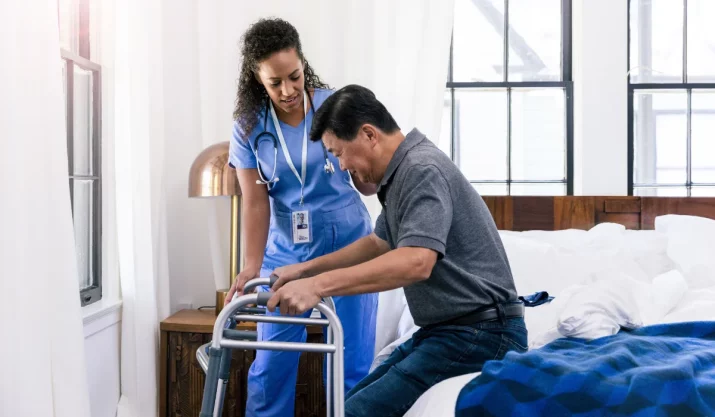When Do You Know It Is Time for a Walking Cane?

Table of Contents
According to Science Daily, the leading cause of death for adults 65 and over is due to falling and related injury. Studies have found that 16.4%of seniors are using a walking cane, while 11.6% are relying on walkers.
Although the human body can be an instinctive indicator and communicator of its own needs, the issue is that many people ignore these signs until it is too late.
With the population of senior citizens expected to double by 2050 – Society will witness a significant restructuring in how walking canes are perceived, developed, and used.
Walking sticks may cause some to scoff at first glance, but if you have experienced a recent fall, noticed a minor imbalance in your step, or simply want to feel more confident of your footing – canes are an excellent option to consider for more independence.
Use this comprehensive guide to learn about the honest questions you should be asking yourself, the benefits of using a cane, insurance details, and how to regain your freedom!
Disclaimer: This is not medical advice, and we recommend seeking the advice of a medical professional.
Determine If You Need a Cane by Asking Yourself These Questions
If you are experiencing any of the symptoms below, it could be time to schedule a consultation with your doctor to seek their advisement on your ailment.
The questions you should be asking yourself include but are not limited to:
Are you in pain?
If you are experiencing soreness in your joints or limbs, you will want to reduce inflammation by minimizing pressure on this area.
Have you injured yourself?
Oftentimes, people use canes temporarily post-injury or post-surgery. If using solely for the duration of your recovery, embrace this support to prevent any future bodily damage or interference in your healing. If you are unsure if you have suffered an injury, consult your doctor as there could be an underlying issue you’re not aware of.
Are you dragging your feet?
Whether it is one foot or both, this is a common sign that you are not lifting your feet as high you should. This can lead to tripping, muscle imbalance, and decreased mobility of that limb due to misuse.
Have you noticed yourself holding the furniture for balance?
If you catch yourself grabbing the back of the couch, holding bookshelves, or using countertops to maneuver around your home, this is incredibly dangerous and should not be continued. Any item could fall on you, or you could lose your balance. Additionally, these furniture items will not be present in the outside world or the general public, so you cannot and should not rely on this method for safe and dependable mobility.
Are you limping?
If you notice an ongoing limp, you should immediately consult your doctor and seek their medical opinion regarding official diagnosis and if cane usage is recommended. It could be a separate issue and should be addressed as soon as possible.
Do you visit places with uneven ground, stairs, or other obstacles?
Perhaps you solely want the freedom to climb the stairs in your home or office but do not typically need a cane elsewhere. We create top-quality stairlifts that are not only attractive but also adaptable to your home’s shape. California Mobility produces Straight Stairlifts and Curved Stairlifts with an industry-leading warranty at a fantastic price! If you only need a cane for this purpose, purchase yours today to avoid injuring yourself greatly. You may not need a walking stick permanently, but you could consider investing in one for specific situations.
Do you feel unstable or off-balance?
The most logical reason of all and the easiest to be honest with yourself about; if you feel off-balance or less-intentional in your footing that you would like to be, it could be time to make the transition to a mobility aid. Visit your doctor because this could also be linked to an inner-ear issue, scoliosis, or related medical concerns.
There are many indications that it is time to join the millions that have invested in their safety and balance – but only you can determine the right time for you.
By taking actionable steps to move easier, you may overcome an injury and not require the cane for long.
Although the ego may try to protect you from the answers and recite the common justification – ‘But I don’t want to look old;’ – Try to set that aside and be honest with yourself given the present circumstance. Some describe a cane as making them feel aged, but this is not a sufficient reason to risk possibly requiring a wheelchair or being completely immobile.
Find perspective on what is most important because self-reliance is hard to put a price on.
Also, if you are asking these questions on behalf of an elderly parent, be sure to check out our comprehensive guide – Understanding Our Elderly Parents and Their Concerns. This can be invaluable to understanding their perspective and the complex psychological dynamics at hand.
Benefits of Using a Cane
In today’s market, there are attractive, stylish, and lightweight canes that will have you moving better than ever, regardless of age.
The main benefits of a walking cane are:
Help with Pain
If you are experiencing pain when trying to maneuver or keep yourself upright, a cane can improve your posture, strengthen your joints, and speed up your recovery time.
You don’t want to risk requiring more than a cane or delaying your recovery by rushing yourself. If you are considering using a walking aid to support your body weight on an affected leg (whether for part-time or permanent use), it may also minimize the amount of cumulative medical bills you could create by worsening the issue.
By taking the time to reduce your pain with a walking stick, you will improve the quality and speed of your recovery while also strength-training your upper body for more muscular arms and shoulders.
Help with Balance
A cane is not there to walk for you, only to support your steps.
By having additional support when you’re standing up, moving around busy areas, or going up stairs – you can feel a great sense of relief in having sure-footing. A cane is an excellent accessory for remaining on your feet without over-exerting yourself.
Again, keep in mind that balance issues could be related to an inner-ear concern and should be addressed by your medical physician. But problems with stability are not uncommon and can lead to rapid exhaustion in mobility, only straining your body more.
Help with Endurance
Walking aids are the ideal answer when someone is experiencing a decrease in their bodily strength, coordination, and range of motion.
When used properly, a cane can lessen the pressure on the injured leg by 25% (according to Verywellhealth.com)
If your rate of perceived exertion is causing your heart to race in situations where it should be moderate (such as walking where your pulse should be regular) – this is a hint that you are pushing your body too hard.
If you are partaking in brisk walks, stair climbing, or other activities that require a higher degree of effort, you could gain a great sense of confidence and capability by having a mobility aid as back-up support.
Help with Independence
More than improving poor posture, your recovery, and stability – Perhaps the most crucial benefit of all is the sense of independence. A cane will not only increase your movement but, moreover, help you regain confidence and freedom to manage your own walking capabilities.
Some may argue, “but I don’t want to be dependent on a cane on a permanent basis.” This argument is a slippery slope that can only make matters worse.
The CDC found that fall rates in the United States have increased by 30% between 2007 and 2016, leading to:
- 3 million older people treated for fall injuries annually
- 800,000 hospitalizations due to falls
- 95% of hip fractures being caused by falling
- Traumatic brain injuries (with falling being the most common cause)
We don’t cite these figures to scare you, only to highlight the reality of possible outcomes.
You may break bones, hit your head, or become permanently injured. In these cases, self-sufficiency would not be your choice anymore (as it currently is), and you may become unable to do every-day activities on your own.
75% of those that fall or have fall-related injuries – were not using a cane.
Point blank – Many falls are preventable.
Please do not take these statistics lightly because we want you to have the independence to keep moving, shaking, dancing, and getting around without further assistance.
If you value your autonomy, there is no safer bet than a walking cane to keep you stable on both feet.
Is It Better to Walk with a Cane or a Walker?
The primary difference between those that need a cane versus a walker is that canes are ideal for those with pain or weakness on one leg while walkers are ideal for those with pain or weakness on both legs.
A standard cane will support your body in remaining upright and often improves posture because a person has been leaning into their weaker side. Chronic back pain can be triggered and throw off your balance, only worsening the impediment.
However, if you feel pain on both sides, find it generally hard to pick up your feet, or trip over things often – these could all be clues that the issue is more significant.
Other factors you will want to consider are:
How Strong Do I Feel?
If you are not self-assured of your body’s abilities, this could be a tell-tale sign that you would benefit from a walker instead of a cane.
To handle a walking stick, it will take a certain degree of upper-body strength. Pushing yourself beyond your natural disposition can lead to premature exhaustion, shoulder pain, and new posture issues from leaning too much into your good leg. You could also worsen your medical condition or hurt your injured side.
Being that walkers have four legs, while a cane only has one leg – If you do not feel strong enough to support your affected leg, a walker will undoubtedly be the most stable option.
How often do I have to go upstairs?
Stairs could be an obstacle that lead you to own both a cane and a walker.
Keep in mind that a walker will be more challenging to manage on a staircase as it won’t fit as narrowly. You can still walk upstairs with a walker, but it must be turned sideways and can be a convoluted process compared to a cane.
Therefore, you may use a walker in your every-day life while keeping a cane close-by the staircase.
As an additional alternative, many recommend investing in a stairlift to simplify this concern.
Am I leaning to one side or worsening my posture?
Many users start with a cane before getting a walker, but sometimes, a health issue may be worse than the cane can manage.
You should always visit a Physical Therapist and obtain guidance on how to properly use your cane to prevent the issue of leaning too much to one side. However, if physical therapy and strength-training on your stronger side are not doing the trick – this could mean that you need a more well-rounded form of support.
A walker could be a better solution for those with a tendency to lean. It will help your shoulders to rest at an even-elevation, keep your back in an upright posture, and prevent the worsening of your ailments. A walker may also be safer if you have scoliosis or other spinal conditions that make even-posture challenging.
What is my fitness level compared to my balance?
Similar to how strong you feel, weigh your body’s endurance against your overall balance. You are researching this subject because your stability is not where you would like it to be – so it is a factor that must be compared to the other questions above.
Without considering your overall balance, the other points are moot.
Even if you feel strong enough to move with a cane, do you notice imbalances on both legs? Are you holding the furniture or under-estimating items on the ground that lead you to trip?
In these instances, it could be best to purchase a walker that will offer the highest form of stability aid, literally quadrupling the legs of support.
Can I Use a Walking Stick Instead of a Cane?
Absolutely! You may also keep one of each on hand for alternative terrains or situations. The choice between these two walking aids will depend on how much support you need, your condition, and if you are experiencing difficulty on one side versus both.
Mobility concerns are typically related to these three factors:
Weight
Thrown off by pain, surgery, or injury.
In the case of weight concerns, a cane will offer one-sided support and could help to reduce the pressure on certain joints. If you have not been diagnosed, this is the first step to understand your pain. If you are post-surgery, your doctor should advise you on this.
Balance
Thrown off by a sensory discrepancy (could be inner-ear, spinal, low vision, etc.)
In the case of balance concerns, a walking stick could also be the safest option because it can assist you in detecting the floor more easily or remedying mild balance concerns (like low vision or peripheral neuropathy).
Endurance
Thrown off by heart conditions, lung functionality, blood pressure, etc.
In the case of endurance concerns, you should consult your doctor because these issues go beyond your leg. A cane could lead to high-demands on your upper-body, which could be too dangerous for your heart if you have high blood pressure, weak lungs, or an arrhythmia.
If you find yourself feeling out of breath often or over-worked after using a cane – A walker may be a superior solution for increased endurance.
Best Uses Highlights
Generally, we would recommend a cane for:
- Short distances
- Stairs
- Maneuvering around tight spaces and corners
- Those with stability issues on one side
- Those with vision issues that need help detecting spatial awareness
We recommend a walker for:
- Longer distances
- When getting out of chairs
- Those with stability issues on both sides
- Those with osteoarthritis, scoliosis, or other balance concerns
- Those with endurance concerns
You may also consider the alternatives of a quad cane, rollators, or mobility scooters.
Does Insurance Pay for a Cane?
Yes, oftentimes, a walking cane will be covered by medical insurance as a durable medical equipment solution (DME).
You do not need a prescription for a cane, but if you get one your costs could be covered (mostly).
Under the original form of Medicare insurance, canes for the blind are not covered, but they will cover those that qualify under the terms of DME.
In many cases, it is possible to have 80% of your costs covered through Part B.
Medicare.org adds:
“If you also have a Medicare Supplement plan, you may have help paying for your coinsurance or deductibles. Medicare Advantage plan members may also include additional benefits that reduce their out-of-pocket expenses or allow them a wider variety of choice in cane types.
Your DME supplier must accept and participate in Medicare, and your Medicare-certified physician may need to provide proof that a cane is a medical necessity for your circumstances in order to qualify for Medicare coverage.”
In Medicare’s specific piece on canes as DMEs, they state:
“Medicare will only cover your DME if your doctors and DME suppliers are enrolled in Medicare. Doctors and suppliers have to meet strict standards to enroll and stay enrolled in Medicare. If your doctors or suppliers aren’t enrolled, Medicare won’t pay the claims submitted by them.”
Consult your health insurance provider and see if there is availability for you to obtain the coverage, rent the equipment, or find alternative solutions.
Feel Better and Gain Freedom!
Although you may be reluctant to embrace a cane, try to reframe this as a way to take back your quality of life.
You may find that you only need extra support in certain terrains, up the stairs, or for designated uses, but you will feel more comfortable and secure having one on hand. It is always better to be safe than filled with regret about not acting when you had the chance.
Ultimately, the best time to get a cane is when you are in need of one. The period of necessity will vary from person to person and could be at age twenty, age ninety, or any other time at which your body communicates this.
Regardless of age, there is no shame in utilizing something that improves your movement and enriches your level of self-sufficiency.
California Mobility is here for your mobility needs because your independence is our greatest gift!
If you’re ready to reclaim your freedom, shop our stairlifts today and request a quote.






